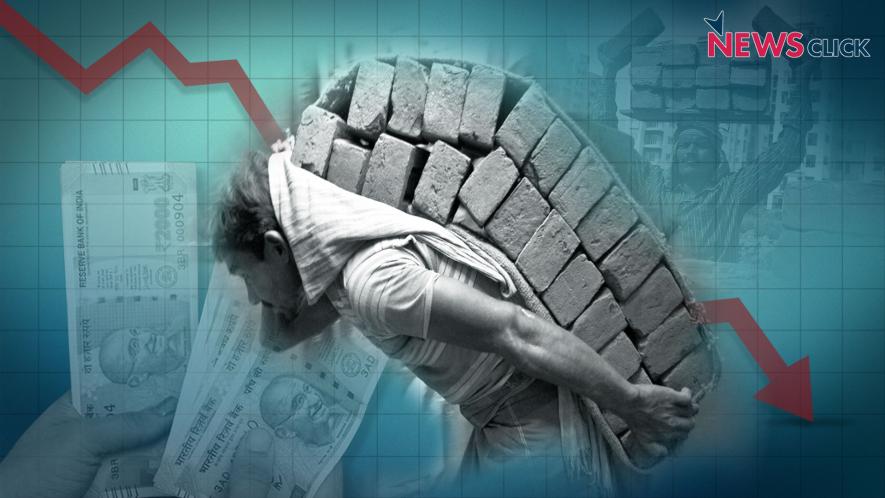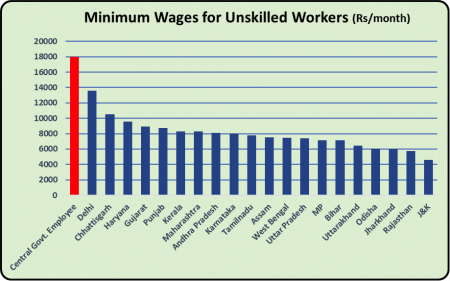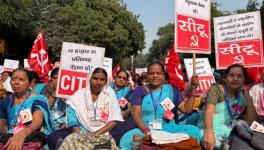Indian Workers on Starvation Wage

Minimum wages of industrial workers in India are less than half of what a justifiable calculation – based on minimum calorific intake and the barest minimum of other expenses – suggests. While the central govt. using a well-accepted standard formula provides Rs.18,000 per month to its lowest rung unskilled worker, their counterparts in private industry are officially supposed to get anything between Rs.6000 to Rs.10,000 monthly. Out of 21 major states with significant industrial employment, 17 states officially fix minimum wages at less than half of the central govt.’s lowest wage. Labour is a concurrent subject in India and hence state govts. have the right to fix wages.

This is of course, only part of the story. In reality, most workers do not even get the prescribed minimum wages. They are given anything between 50% to 75% of the statutory levels. Since enforcement machinery – labour departments with their inspectors and courts – have been hollowed out over the years, there is no enforcement and flagrant violation.
How much wage does a worker need?
Way back in 1948, British nutritionist Wallace R. Ayckroyd defined the food requirement for an Indian worker doing moderate activity as a minimum of 2700 kCal per day, including 65 g of protein and 45-60 g of fat. Nine years later, at the 15thIndian Labour Conference (ILC), this was accepted as the basis for calculating the minimum wage needed to sustain a worker and his family.
The ILC laid down that retail prices of a mix of various food types (pulses, cereal, vegetables, oil/fat etc.) should be collected to arrive at quantities and costs of food for a worker. In addition, 18 yards of cloth (with washing costs), 7.5% of the cost so reached for housing rent and 20% for fuel, lighting etc. should be added.
Since the worker will also have to sustain his family, it was posited that a standard family would be the worker, his wife and two pre-adolescent children. This would be seen as equivalent of three units (worker – 1 unit; wife – 0.8 unit; and two children – 0.6 units each).
So, the cost of food, clothing etc. is multiplied by 3 to get what was named ‘minimum wage’. All this calculation is succinctly explained in the 7th Pay Commission Report (pp 60).
One obvious omission from this calculation was that education, recreation and such other spending of the hapless worker’s family were totally ignored. It took another 33 years before the Supreme Court, in a landmark judgement delivered in 1991 in Reptakos Brett Vs Workmen, ordered that another 25% of the total should be added to cover these omitted costs. Henceforth this became the basis of minimum wage fixation.
In 2016, the Seventh Pay Commission (a statutory body set up every four years to revise salaries of the central govt. employees) brought out its report. It went through the exercise of recalculating the lowest salary applicable for the bottom rung of govt. employees. The rest of the salary structure is built up from this base. And, the formula it used was the one described above -0 15thILC recommendations and the apex court’s judgement in Reptakos Brett.
What was the outcome? It recommended that Rs.18,000 is the bare minimum that should be paid to the lowest rung of employees, unskilled workers. Actually, the sum was working out to more than that but the Commission adjusted for already fixed allowances for education etc. and fixed it at Rs.18,000.
Note that there are still glaring loopholes in this calculation, persisting from the 15thILC itself. For instance, no account is taken of aged parents of the worker, who will be staying with the young family. Also, the counting of women as 0.8 unit is unjust and discriminatory. But still that’s the standard.
How do workers cope?
It is difficult to imagine the lived reality of lives of industrial workers who are surviving on wages as low as Rs.6000 or 7000 in modern 21stcentury India. For one, most workers try to work ‘overtime’ – extra hours – provided their employer needs more work. The average worker may be working as many as 10-12 hours per day. Legally, the extra hours should fetch the worker double the hourly wage. But nobody pays that much. It is ‘single’ overtime rate, that is pro rata. But the cash starved worker bargains away his life, his health, his well-being, working those extra hours. Secondly, the family cuts down on food expenses, foregoing expensive items like meat and eggs and milk and fruits. They save money by living in shanties without drainage or sanitation. They avoid expensive schools and almost never educate children beyond schooling. They take recourse to quacks and indigenous ‘cures’ to save on medical expenses, unless faced with some catastrophic illness. They become indebted. And so, they somehow manage to live.
Over the years, workers have been demanding higher wages. But under neo-liberal regimes, like the one in India, there is no sympathy for the workers’ welfare. In fact, real wages have stagnated or declined, as inflation robs the workers. Mounting joblessness keeps wages depressed as insecurity over jobs rules the hearts of all those employed.
Yet, the fight for better conditions is gathering momentum. There have been two massive industrial strikes (in 2015 and 2016) and a giant sit-in at Delhi last November. Now, trade unions have called for a courting-arrest programme on 9 August followed by a historic rally at Delhi on 5 September this year, jointly with farmers’ organisations. The anti-worker Modi govt. is facing a desperate working class, angry and ready for a fight.
Get the latest reports & analysis with people's perspective on Protests, movements & deep analytical videos, discussions of the current affairs in your Telegram app. Subscribe to NewsClick's Telegram channel & get Real-Time updates on stories, as they get published on our website.
























